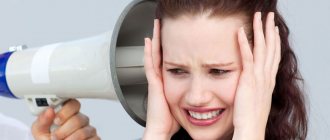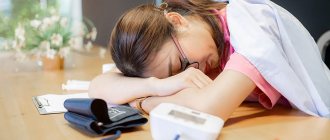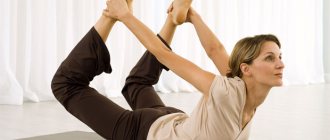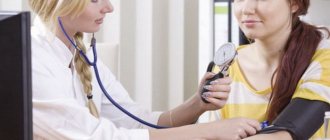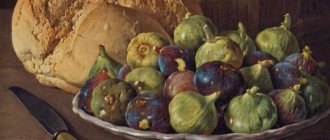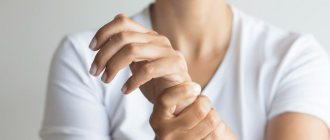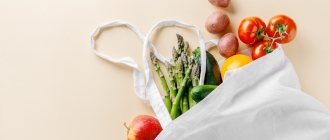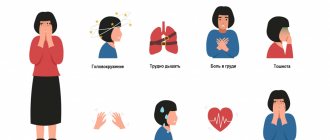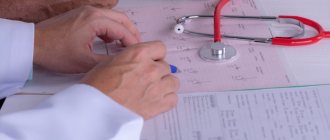Vegetative-vascular dystonia: persistent symptoms
- Cardialgia. Pain in the left side of the chest that is not due to heart damage. These symptoms are not specific to VSD; they can occur in many other diseases.
- Heartbeat problems . Common symptoms of VSD are rapid or slow heartbeat, irregular heart rhythm (arrhythmia).
- Vascular dystonia . Constriction of blood vessels causes blood flow to slow down. Because of this, internal organs suffer, which do not receive enough oxygen and nutrients.
- Respiratory disorders . Shortness of breath, difficulty breathing, feeling of lack of air.
- Systemic neurotic disorders . The patient suffers from insomnia and nervousness.
Eliminating symptoms
After the diagnostic measures have been carried out, the specialist prescribes several groups of drugs aimed at relieving the patient of the symptoms that bother him.
- Sedatives (Novo-Passit, Persen): calm and reduce anxiety.
- Strengthening the cardiovascular system (Asparkam, Panangin): improving heart function and vascular permeability.
- Nootropics (Cofin, Piracetam): improve brain function.
- Tranquilizers (Relanium, Phenazepam): with strong sedative properties.
- Antidepressants (Prozac, Remeron): relieving the patient of depression.
- Neuroleptics (Teraligen, Eglonil): having antidepressant and psychostimulating effects.
Treatment of VSD: lifestyle correction and diet
To get rid of VSD, you need to eliminate the cause of the disease and normalize the functioning of the autonomic nervous system. This will help you:
- Full sleep. It is important to sleep at least 8 hours a day and go to bed at the same time. To ensure a restful sleep, it is advisable not to overeat at night, open windows for ventilation and ensure a comfortable temperature in the room.
- Healthy eating. Animal fats should be replaced with vegetable fats, which are found in nuts, grapes, and olives. It is better to exclude or reduce the amount of fatty, fried foods.
- Physical exercise. If there is no time for regular training, morning exercises, regular walking or cycling will be enough.
- Massage. Massage of the head and collar area helps against headaches due to VSD, and massage of the torso and limbs helps against low blood pressure.
To find and treat the root cause of VSD, contact the doctors at the Medicenter clinic. Specialists will conduct an examination, identify the problem and prescribe effective treatment.
Vitamins for VSD
After being diagnosed with dystonia, people wonder what vitamins to take and how to take them. All groups of beneficial substances can benefit a person (if the dosage regimen is not violated), but some of them are especially important for people suffering from VSD.
To notice the best effect of vitamin exposure, you should evaluate the manifestations that occur in people suffering from their deficiency:
- the skin is peeling;
- hair fall out;
- acne occurs;
- nails and hair become dull;
- mood worsens;
- feeling weak.
People with VSD are especially susceptible to negative manifestations of vitamin deficiency, in the form of depression, neuroses and other central nervous system crises.
- How to effectively treat vegetative vascular dystonia - necessary advice and medications for the treatment of VSD
To determine what vitamins a particular patient needs for VSD, a blood test should be performed. The doctor will evaluate its results and recommend suitable compositions or elements to take.
Thiamine
Vitamin B1 brings the following benefits to the body:
- regulates brain function;
- stabilizes blood circulation;
- acts as an angioprotector and antioxidant, which is especially important for VSD;
- improves attention;
- enhances carbohydrate metabolism;
- eliminates muscle weakness;
- gives strength.
Thiamine is found in the following foods:
- bread;
- pig liver;
- milk and its derivatives;
- beef;
- cereal products;
- black currant.
We recommend reading: How to overcome drowsiness during VSD
The sufficient amount of thiamine to take per day is 2.5 mg.
Vitamin A
Retinol is the basis for the harmonious development of the human body; it performs the following functions:
- improves vision;
- improves the functioning of the central nervous system;
- starts skin regeneration processes;
- increases the body's defenses;
- moisturizes the skin;
- slows down aging;
- maintains dental health;
- eliminates peeling;
- triggers regeneration of the autonomic part of the nervous system;
- improves the appearance of hair, accelerating its growth and adding volume.
Vitamin A is needed by people of any age, especially those in active growth and development.
- Vegetative vascular dystonia medications - list
To replenish the daily need of this element in the body (about 800-900 mcg), you should consume the following foods daily that contain it:
- green salad leaves;
- butter;
- fresh carrots;
- oil of marine fish;
- green onions.
Riboflavin
Riboflavin is an element without which the nervous system will not function properly. Doctors usually prescribe it among other medications prescribed for VSD.
Vitamin B2 has the following effects on the body:
- leads to normal carbohydrate-protein metabolism;
- adjusts regeneration processes;
- renews blood vessels;
- participates in the construction of cells;
- helps in the absorption of iron;
- strengthens the immune system;
- calms the central nervous system, setting it up for productive work;
- improves color perception by the organs of vision;
- leads to normal functioning of the thyroid gland.
Riboflavin is often prescribed to patients if they have nervous conditions, because it has the ability to neutralize their manifestations.
Vitamin B2 is found in:
- liver;
- tomatoes;
- cabbage;
- cottage cheese;
- kidneys;
- chicken eggs;
- buckwheat;
- dairy products.
You should carefully monitor the amount of vitamin consumed to prevent an overdose, which can impair liver function. 1.8 mg of this element per day is enough.
Pantothenic acid
Vitamin B5 is widely distributed and can be easily obtained from plant and animal foods.
Benefits of pantothenic acid:
- strengthens the walls of blood vessels;
- heals damage to the skin due to active stimulation of regeneration processes;
- maintains healthy appearance of nail plates;
- balances the processes occurring in the autonomic part of the nervous system.
The foods richest in vitamin B5 content, in which you can find a daily amount of 5 mg, are called:
- Increased blood pressure with VSD
- peas;
- sorrel;
- nuts of different types;
- beef liver;
- chicken eggs;
- onion;
- oat groats.
Pyridoxine
This is a strategically important element belonging to the B vitamins. Pyridoxine is responsible for many processes occurring in the human body.
Vitamin B6 brings the following benefits to the body:
- increases the resistance of the central nervous system to stress;
- reduces the risk of negative reactions from the central nervous system to different situations;
- participates in the production of red blood cells;
- controls metabolism;
- responsible for supplying the nervous system with glucose.
Pyridoxine can be found in:
- potatoes;
- carrots;
- strawberries;
- cherry;
- lemons
We recommend reading: Cold limbs - why and how to treat?
A person needs 2-5 mg of vitamin per day, but in special cases (in the presence of daily stress), the doctor may increase this dose.
Cyanocobalamin
This vitamin is very important for people with vegetative-vascular dystonia. Cyanocobalamin helps:
- increase immunity;
- maintain blood pressure at the desired level;
- eliminate nervousness;
- reduce fatigue;
- normalize complexion;
- eliminate tachycardia and shortness of breath;
- renew the cellular composition of the blood;
- eliminate back and lower back pain;
- reduce high blood pressure by regulating heart function;
- restore brain cells;
- improve appetite.
The dose of cyanocobalamin required by the human body (2.4 mcg per day) can be found in the following products:
- liver, both pig and cow;
- kefir;
- kidneys;
- cod and other seafood.
Cyanocobalamin should be used with caution. It is important to make sure that there is no individual intolerance to it in order to prevent serious allergic reactions.
Ascorbic acid
Ascorbic acid is involved in various processes occurring in the human body:
- increases resistance to infections;
- controls blood clotting;
- regulates the production of neurotransmitters;
- increases protein digestibility;
- makes veins and vascular walls elastic;
- maintains cholesterol at the desired level;
- reduces the risk of allergies;
- removes inflammation.
Vitamin C can be found in:
- citrus fruits and raspberries;
- currants and rose hips;
- cabbage and beets;
- carrots
To restore body functions, it is enough to consume about 80 mg of ascorbic acid per day.
Vitamin D
Vegetative vascular dystonia requires the presence of a sufficient amount of vitamin D in the human body, otherwise the nervous system will work unstably.
This vitamin helps prevent:
- development of rickets (especially in young children);
- weakness of bone tissue;
- the occurrence of osteoporosis;
- the appearance of limb spasms;
- diseases of the cardiovascular system;
- skin damage.
You can get this vitamin from the following foods:
- cottage cheese;
- milk;
- fish fat.
An adult needs from 5 to 10 mcg of vitamin D per day. In addition to its direct consumption in food, the vitamin can be obtained while walking outside in sunny weather.
Vitamin E
Tocopherol, also called vitamin E, is involved in the production of hormones, which is why it is so important for the female body.
This substance is responsible for:
- the ability to conceive men and women;
- ability to improve blood clotting;
- accelerates regenerative processes in skin cells;
- protects against aging;
- reduces the impact of toxins on the body;
- prevents the occurrence of atherosclerosis;
- reduces the risk of vascular and heart pathologies.
Vitamin E is found in:
- seeds and nuts;
- vegetable oil from sunflower and spinach;
- yolks of chicken eggs.
The recommended dose for an adult is 20 mg of vitamin E per day.
Vitamin K
This vitamin has the unique ability to be independently produced by human intestinal cells, so its deficiency is quite rare.
We recommend reading: Diagnostics of VSD: what equipment is used for this procedure?
Functions performed by vitamin K:
- improves blood clotting;
- neutralizes toxins;
- renews cellular composition.
This substance is found in:
- potatoes and carrots;
- cabbage and nuts;
- veal and pork liver;
- soybean oil and all green crops.
A person needs about 120 mg of the vitamin per day.
Niacin
Niacin
Niacin has 2 other names: B3 and niacin. The benefits that this substance provides to the human body are difficult to overestimate:
- energy consumption control;
- preventing the formation of lipoproteins;
- strengthening the heart and blood vessels;
- synthesis of hormones;
- normalization of sleep;
- cleansing the skin;
- improving the functioning of the gastrointestinal tract;
- optimization of the central nervous system.
You can replenish the content of this vitamin in the body with the help of mushrooms, yeast, peanuts and liver.
A person should receive 20 mg of nicotinic acid per day.
Vitamin P
This vitamin is mainly responsible for the health of the blood vessels of the circulatory system, which is very important for people suffering from VSD and its manifestations.
This substance has the following effects:
- destroys free radicals;
- normalizes blood pressure;
- increases the elasticity of vascular walls;
- leads to normal gastrointestinal tract;
- stimulates the functioning of the gallbladder;
- reduces the effects of stress on the central nervous system.
The daily amount of vitamin P (from 20 to 25 mg) can be obtained by eating grapes, oranges and apples, cherries and lemons, potatoes and chokeberries.
Signs of a panic attack
Many people, unfortunately, do not understand that they were “visited” by a panic attack, believing that their heart suddenly “grabbed”. Indeed, the symptoms of a panic attack are similar to a vegetative crisis: rapid heartbeat, pulsation in the temporal regions, lack of air - difficulty breathing, pain in the chest and abdomen. However, medications taken “for the heart” do not improve the condition in any way.
Also, at these moments, a person begins to either sweat or feel chills, his limbs tremble, the skin becomes numb or tingles, there may be dizziness and nausea, and an upset stomach. Everything seems unreal to him, blurry, that this is not happening to him (derealization and depersonalization), he goes crazy or dies. The patient experiences incredible fear, but there are also individuals who, instead, feel sadness; they always want to cry or be aggressive.
We can talk about the presence of a mental disorder such as panic attack syndrome if attacks occur several times a day or a couple of times a month, and last several minutes or up to an hour (the average is from 15 to 30 minutes).
The attack appears unexpectedly, without any pretext, and not in some frightening or alarming situation: in a store, on the street, in a cinema, while driving a car, at home - on the sofa, and even in a dream. A person at this moment can either be among people or be alone.
It can hardly be said that all of the above is dangerous to health, but panic attacks can lead to the development of neuroses, depression, and phobias. A patient, having experienced an unexpected attack, even a very short one, several times, tries to do everything to avoid a recurrence. He becomes suspicious, loses confidence, constantly “listens” to himself, gets nervous and tries to avoid places and situations where and in what case this happened. That is, now he is afraid of just such an attack and lives in constant anxiety and phobic avoidance.
The mechanism of the onset of panic disorder is very simple to explain using an example. A completely prosperous person, usually a strong personality, living a normal life, received a very strong emotion (anger, fear, etc.) in a certain traumatic situation. The brain absorbs this experience and stores it in the unconscious. That is, the individual himself seems to have forgotten everything, but this is far from the case: the negative is securely stored in a distant corner of the memory and, over time, added to it are memories of the troubles that inevitably accompany our life, no matter how wonderful and calm it may be .
One fine day, some significant event happens, very joyful or sad (the birth of a child, the death of a parent), and it, by coincidence, becomes the last straw that overflows the vessel with memories. Then it “explodes” and the person has a panic attack.
This sudden attack worries and worries a person, even if it passed very quickly. Such a lack of understanding of what happened, anxiety, tension and excess emotions about this can provoke another attack, and then they will happen again and again. The patient is frightened by his physical and mental state at these moments, he tries not to visit those places where he was overtaken by an attack - phobias appear. As a result, panic disorder develops, and if this problem is left to chance, the consequences can be very sad.
